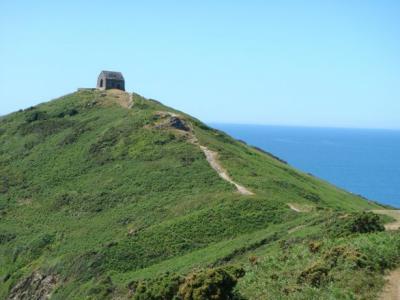
Web: www.visitrame.org.uk
Maker with Rame Parish Council
Most easterly headland on Cornwall's south coast
Rame Head, the cone-shaped headland at the western entrance to Plymouth Sound, is topped by the ruins of a medieval chapel dedicated to St. Michael, which makes an impressive landmark from many miles along the coastpath westwards along Whitsand Bay. It also supports the earthwork remains of an Iron Age fort. The church in the tiny hamlet of Rame dates from Norman times and the slate tower with its broached spire is a notable landmark. To the west are the sweeping sands and beaches of Whitsand Bay, where numerous ships have been driven ashore while trying to round Rame Head in a gale.
The chapel was first licensed for Mass in 1397 and is on the site of a much earlier and ancient, Celtic, hermitage. It remains as an intact shell and was originally lime-washed so that it stood out on the headland. Ordwulf, who was the owner of vast estates in the West Country and was the uncle of King Ethelred the Unready, gave Rame to Tavistock Abbey (which Ordwulf had founded) in 981, meaning the parish was technically in Devon until the modern period.
Eight miles south of the headland, and just visible on a clear day is the Eddystone reef, the scene of so many wrecks that it was decided to erect a lighthouse there - the first ever to be built on a wave-swept rock. Henry Winstanley erected the first one on the site in 1698; it was re-built the following year, and he lost his life, with others, when the replacement was swept away during a storm in 1703. The present, and fifth, lighthouse to be built on the rock was designed by James Douglass and completed in 1882.
About a mile to the east is Penlee Point with excellent views over Plymouth Sound. Above the point, a little below the Coastal Path, is Queen Adelaide's Grotto, built in 1827/1828 to commemorate the visit of King William IV and Queen Adelaide to Mount Edgcumbe. Penlee Battery is the former site of a fort, and is now a nature reserve. The Old Signal House here is one of three adjoining cottages that was formerly a Trinity Lighthouse Service Signal Station built at the turn of the last century to house the families of the light house keepers at Eddystone Lighthouse.
Right on the end of the road next to the car park is the National Coastwatch Institution lookout, giving amazing views up and down the coast.
To the east of Rame Head, around Penlee Point, are the little-visited, attractive and unspoilt old fishing villages of Cawsand and Kingsand, where the future Henry VII landed before the Battle of Bosworth; later the villages were a smugglers' haven, and beyond, Mount Edgcumbe Country Park with 800 acres of parkland, gardens and woodland overlooking Plymouth, Drakes Island and the Sound.
Downderry Eddystone Lighthouse Looe Millbrook Portwrinkle Saltash Torpoint
Cawsand & Kingsand Mount Edgcumbe Country Park The Coastal Footpath Whitsand Bay